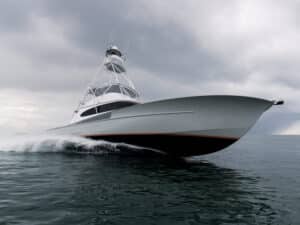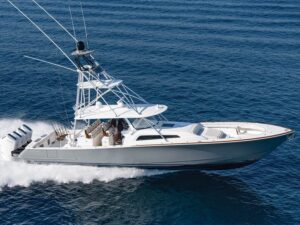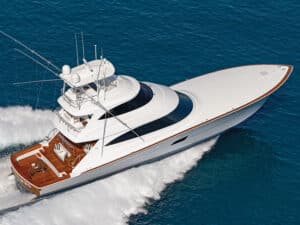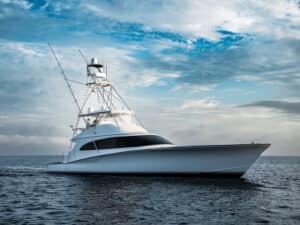Paul Spencer qualifies as about the most progressive custom boatbuilder in America. He pushes the limits – even in the midst of naysayers. So it goes with several of his new boats powered by Volvo Penta’s Inboard Propulsion System (IPS). Skeptics abound, but so far, everyone who actually drives one develops the passion of a convert. It certainly doesn’t hurt that Spencer’s boats exhibit all of the speed, beauty and fishing success no matter what power option he decides to put in them.
Volvo commissioned Spencer – based on his previous success in creating beautiful IPS-powered custom fishing boats – to build its new corporate flagship, Penta Gone, to showcase the abilities and efficiencies of IPS power.
**Performance
**Penta Gone is a 70-footer that sports three engines with a total of 2,700 hp between them. Most 70-footers come with a pair of 2,400 hp or 2,600 hp diesels – almost twice the horsepower of Penta Gone. Consequently, the boat’s weight, and how to distribute it, became the most critical design challenge. Going back through many previous tests of comparable boats, my sea trial showed that this Spencer 70 IPS burned about 40 percent less fuel at the same speeds as some of the higher-powered sport-fishers I’ve run.
The balance of this boat is so exacting that it exhibits a barely measurable bow rise, and the running attitude virtually never changes.
Running out of tiny Rudee Inlet in Virginia Beach, Virginia, conditions proved downright sporty with 6-foot seas at the mouth and a gauntlet of 100 tiny johnboats trying to fill their bilges with speckled trout lining the waterway. A nerve-racking transit on so many levels!
Cruising straight into the offshore seas at 20 knots proved a non-event – at least until we suddenly came upon a set of 8- to 10-footers, which caused us to back off. Once past the shallows, we could turn beam-to the seas and continued running smooth and dry at 30 knots while turning 2,040 rpm.
Volvo QL trim tabs actually stem from a design by Humphree Interceptor trim tabs. Spencer decided to opt for the Humphree tabs because Volvo doesn’t make any blades big enough for a 70-footer. Through the miracle of software, not only do these tabs adjust fore, aft and lateral trim (shaving four to six seconds off time to plane in the process), they also work as stabilizers.
Most boats never undergo performance or speed runs with completely full tanks – it just doesn’t show optimum performance. But Penta Gone needed to leave for the Fort Lauderdale Boat Show the morning following our test, so it was already fully loaded with fuel. Even under all that extra weight, she topped out at just over 38 knots while turning 2,362 rpm and burning 134 gph total. The triple 900 hp diesels burned about 77 gph at 25.5 knots while turning 1,800 rpm. And where most boats this size cruise today – at 30 knots – we used a total of 108 gph. I’m certain a half load of fuel would improve both speed and efficiency.
With the rotating pods rather than rudders steering the boat, this 70-footer turns beautifully at cruise – slowing down scribes an ever-tighter arc.
Sport Fish mode on this boat qualifies as truly remarkable. With Sport Fish engaged, you can back down straight as an arrow at 10 knots without taking a drop over the covering boards and spin the boat around like it’s a 30-footer. It changes direction like a quarter horse. And the dynamic positioning system holds you within a few feet of any position while holding the same heading – remarkable.
**Design and Construction
**The overall design was a cooperative in-house effort of Paul Spencer, Larry Belkov and the engineering team at Volvo Penta. They created the entire boat: systems, furniture, hull, super-structure – everything – on a computer prior to construction. Start to finish, the project took 18 months to complete, with three months spent on design work alone. Generally, a boat this size would hit the water 25 to 28 months after startup.
Everything in the boat is weight conscious. Belkov helped with the overall design as well as the interior. Much of the engine room was pre-built at Volvo as a full-scale mockup. The modular interior consists mostly of Tri-Cell coring and light ply. The composite hull (with solid glass at each thru-hull) uses a layer of Kevlar over a foam composite core.
Starting with Spencer’s proven 70-foot hull, the IPS team made only minor design changes in the running surface to improve the performance with IPS, including more aggressive chines and decreased rocker at the transom. Rocker helps lower the running angle of a boat with standard propulsion, something that’s unnecessary with the IPS thrust running parallel to the water’s surface.
**Engine Room
**Not only does the engine hatch from the cockpit rise on pneumatic rams, but when it closes, an internal gasket inflates slightly to produce a watertight, soundproof seal.
Spencer moved a lot of equipment from the engine compartment to the forward cabin bilge for several reasons: to accurately place the center of gravity and to help clean out the engine spaces – since they end up being considerably smaller with IPS drives. The forward engine room bulkhead is 9 feet farther aft than on a standard-propulsion boat. That means loads of more living space belowdecks, especially in the master stateroom amidships.
You can access the crew’s quarters – with its two athwartship singles, head and shower – through the transverse bulkhead crash door in the engine room. Ultimately, this engine compartment turned out to be one of the most maintenance-friendly I’ve seen.
**Flybridge
**Unlike the bright, airy spaces down below, the flybridge, with its all-black decor, sucks up light like Darth Vader’s bedroom – but with a purpose. You’ll see little or no reflection when looking through the flybridge windows while driving from the aft station. From those same aft overhang controls, you can see the entire fighting chair and everything else you’d need to monitor while fighting a fish.
**Cockpit
**Not that Volvo expects problems, but the mezzanine – with all of its refrigerators, freezer storage and Kenyon grill – is completely removable, making swapping out engines a breeze without having to cut bulkheads or salon floors. The transom live well, with a built-in aquarium window, is large enough to double as a sizable fish box.
One fabulous innovation needs mentioning even though it’s on the foredeck: From the deck or anywhere outside the boat, you can’t see the Anchorlift windlass or anchor. Rather than having a bow pulpit with rollers, a press of a button opens wing-like doors just below the rail on the stem and lowers the anchor into the water. Upon retrieval, the anchor disappears behind the doors, which close automatically.
Also forward, the center third of the cabin front is actually a tinted window that blends in with the mask. This window allows tons of ambient light to enter the salon and the belowdecks cabin area.
**Interior
**The elevated galley affords an unobstructed view both outside and down into the cockpit. I really like the almost-full-width dining table all the way forward. And the tinted cabin-front window provides great ambient light as well as a view of the bow.
The master cabin sports unique in-hull windows that look beautiful from the inside – not so much from outside, in my opinion.
A guest double to port with fore, aft and athwartship twin berths boasts an interesting electrified glass window to the companionway that can be clear or translucent for privacy at the touch of a button. This is a particularly nice feature, since the huge cabin-front window dumps loads of light down the stairway and through that window.
The guest cabin in the bow sports an island queen berth and private head with shower. This cabin also gives access to the unusual belowdecks compartment where lots of equipment that normally resides in the engine room hides. That’s where Spencer installed the chilled-water air-conditioning compressors, watermaker, numerous pumps, plumbing and tons of storage. The AC units don’t have to work as hard in this space since the ambient temperature is lower than what’s found in the engine room, and the units don’t suffer external condensation as a result.
It’s no secret that the offshore-fishing community can sometimes be averse to change. But pod propulsion represents a truly improved mousetrap. Better economy, more interior room and phenomenal performance that you have to experience to believe! And it actually makes docking your boat in adverse conditions fun! As for raising fish, Penta Gone released 42 marlin in a two-week stretch during last summer’s tournament circuit – that’s plenty good enough for me.
Specifications
LOA……70’6″
Beam……20’4″
Weight……83,000 pounds
Draft……5’1″
Fuel……1,380 gallons
Water……220 gallons
Power……Triple Volvo IPS 900 hp
Price……On request
_Spencer Custom Yachts / Wanchese, North Carolina / 252-473-6567 / spenceryachtsinc.com
_







